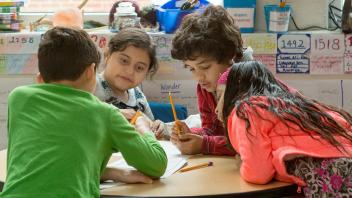What is reciprocal teaching?
Reciprocal teaching is a cooperative learning strategy that aims to improve students’ reading comprehension skills. A group of students take turns acting as the teacher in guiding the comprehension of a text. The strategy was developed by Annemarie Palincsar and Ann L. Brown in the 1980s.
Reciprocal teaching typically involves four main strategies or activities:
Predicting: Students make predictions about what they think will happen in the text based on prior knowledge and information from the text.
Clarifying: Students ask for clarification about parts of the text that are confusing to them. This can involve questioning unclear vocabulary, concepts, or statements.
Questioning: Students generate questions about the content of the text. These questions can be about specific details, main ideas, or inferences.
Summarizing: Students summarize the main ideas of the text in their own words. This helps reinforce understanding and identify key information.
The unique aspect of reciprocal teaching is that students take turns leading the group discussions using these four strategies. The teacher’s role is to model the process initially and then gradually hand over the responsibility to the students. The reciprocal nature of the strategy promotes collaboration, active engagement, and metacognition (thinking about one’s own thinking).
Why use reciprocal teaching?
- It encourages students to think about their own thought process during reading (metacognition).
- It helps students learn to be actively involved and monitor their comprehension as they read.
- It teaches students to ask questions during reading and helps make the text more comprehensible.
- It can be adapted for different content areas.
Key Information
Focus
When To Use This Strategy
Appropriate Group Size
How to use reciprocal teaching
Before reciprocal teaching can be used successfully by your students, they need to learn about and practice the four strategies that are used in reciprocal teaching — predicting, clarifying, questioning, and summarizing.
Getting students ready
(from Donna Dyer of the North West Regional Education Service Agency in North Carolina)
- Put students in groups of four.
- Distribute one note card to each member of the group identifying each person’s unique role:
- Summarizer
- Questioner
- Clarifier
- Predictor
- Have students read a few paragraphs of the assigned text selection. Encourage them to use note-taking strategies such as selective underlining or sticky-notes to help them better prepare for their role in the discussion.
- At the given stopping point, the Summarizer will highlight the key ideas up to this point in the reading.
- The Questioner will then pose questions about the selection:
- Unclear parts
- Puzzling information
- Connections to other concepts already learned
- The Clarifier will address confusing parts and attempt to answer the questions that were just posed.
- The Predictor can offer predictions about what the author will tell the group next or, if it’s a literary selection, the predictor might suggest what the next events in the story will be.
- The roles in the group then switch one person to the right, and the next selection is read. Students repeat the process using their new roles. This continues until the entire selection is read. (Source: ReadingQuest )
- Throughout the process, the teacher’s role is to guide and nurture the students’ ability to use the four strategies successfully within the small group. The teacher’s role is lessened as students develop skill.
For more information, see the article Reciprocal Teaching for the Primary Grades: “We Can Do It, Too!”.
Watch reciprocal teaching in action
At Frank Love Elementary School, reading expert Shira Lubliner uses reciprocal teaching to guide students in learning to lead a classroom discussion. But first, Ms. Lubliner shows them how to guide a conversation about a book.
Collect resources
- This “Train Your Brain to Read” bookmark provides prompts for each of the four strategies used in reciprocal teaching.
- Similar to the bookmark above, this four-column handout prompts students with questions and statements related to the four strategies.
- This worksheet incorporates all four strategies into one page that students can fill out. See an example of a filled-in worksheet for the book The Man Who Walked Between the Towers.
Differentiate instruction
For second language learners, students of varying reading skill, and younger learners
- Pair a student with lower reading skills with one who is more advanced to work together.
- Ask student to write out questions about parts of the story that doesn’t make sense to them.
See the research that supports this strategy
Oczuks, L. (2003). Reciprocal teaching at work: Strategies for improving reading comprehension. Newark, DE: International Reading Association.
Palincsar, A. S. & Brown, A. (1984). Reciprocal Teaching of Comprehension-Fostering and Comprehension Monitoring Activities. Cognition and Instruction, 1(2), pp. 117-175.
